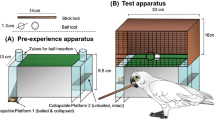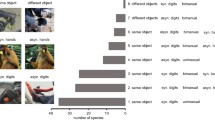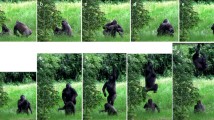Abstract
We conducted two experiments to examine the manipulative tendencies of captive Cebus albifrons. In Experiment 1 we examined hand preference for reaching by providing subjects with food either on the cage floor (to facilitate quadrupedal reaching) or at the height of an upright subject's shoulder (to facilitate bipedal reaching). In Experiment 2 we examined combinatorial manipulation by providing subjects with nesting containers and other portable manipulanda. Results indicate that C. albifrons exhibits greater use of the right hand for bipedal versus quadrupedal reaching (exhibiting a group-level lack of bias for bipedal reaching and a left-hand bias for quadrupedal reaching), combines objects using a simple pairing strategy, and uses and produces simple tools. Aspects of these findings parallel those for Cebus apella.
Similar content being viewed by others
REFERENCES
Defler, T. R. (1979a). On the ecology and behavior of Cebus albifrons in eastern Columbia: I. Ecology. Primates 20: 475–490.
Defler, T. R. (1979b). On the ecology and behavior of Cebus albifrons in eastern Columbia: II. Behavior. Primates 20: 491–502.
Defler, T. R. (1982). A comparison of intergroup behavior in Cebus albifrons and C. apella. Primates 23: 385–392.
Fragaszy, D. M., and Adams-Curtis, L. E. (1991). Generative aspects of manipulation in tufted capuchins (Cebus apella). J. Comp. Psychol. 105: 387–397.
Hopkins, W. D. (1993). Posture and reaching in chimpanzees (Pan troglodytes) and orangutans (Pongo pygmaeus). J. Comp. Psychol. 107: 162–168.
Kinzey, W. G. (1997). Synopsis of New World primates (16 genera). In Kinzey, W. G. (ed.), New World Primates: Ecology, Evolution, and Behavior, Aldine de Gruyter, New York, pp. 169–305.
MacNeilage, P. F., Studdert-Kennedy, M. G., and Lindblom, B. (1987). Primate handedness reconsidered. Behav. Brain Sci. 10: 247–303.
Matsuzawa, T. (1991). Nesting cups and metatools in chimpanzees. Behav. Brain Sci. 14: 570–571.
McGrew, W. C. (1992). Chimpanzee Material Culture: Implications for Human Evolution, Cambridge University Press, Cambridge.
Pagano, R. R. (1986). Understanding Statistics in the Behavioral Sciences, West Publishing Company, New York.
Visalberghi, E. (1990). Tool use in Cebus. Folia Primatol. 54: 146–154.
Westergaard, G. C. (1994). The subsistence technology of capuchins. Int. J. Primatol. 15: 899–906.
Westergaard, G. C., and Suomi, S. J. (1994). Hierarchical complexity of combinatorial manipulation in capuchin monkeys (Cebus apella). Am. J. Primatol. 32: 171–176.
Westergaard, G. C., Kuhn, H. E., Lundquist, A. L., and Suomi, S. J. (1997). Posture and reaching in tufted capuchins (Cebus apella). Laterality 2: 65–74.
Wrangham, R. W., McGrew, W. C., de Waal, F. B. M., and Heltne, P. G. (eds.) (1994). Chimpanzee Cultures, Harvard University Press, Cambridge, Massachusetts.
Author information
Authors and Affiliations
Rights and permissions
About this article
Cite this article
Westergaard, G.C., Wagner, J.L. & Suomi, S.J. Manipulative Tendencies of Captive Cebus albifrons . International Journal of Primatology 20, 751–759 (1999). https://doi.org/10.1023/A:1020756803437
Issue Date:
DOI: https://doi.org/10.1023/A:1020756803437




